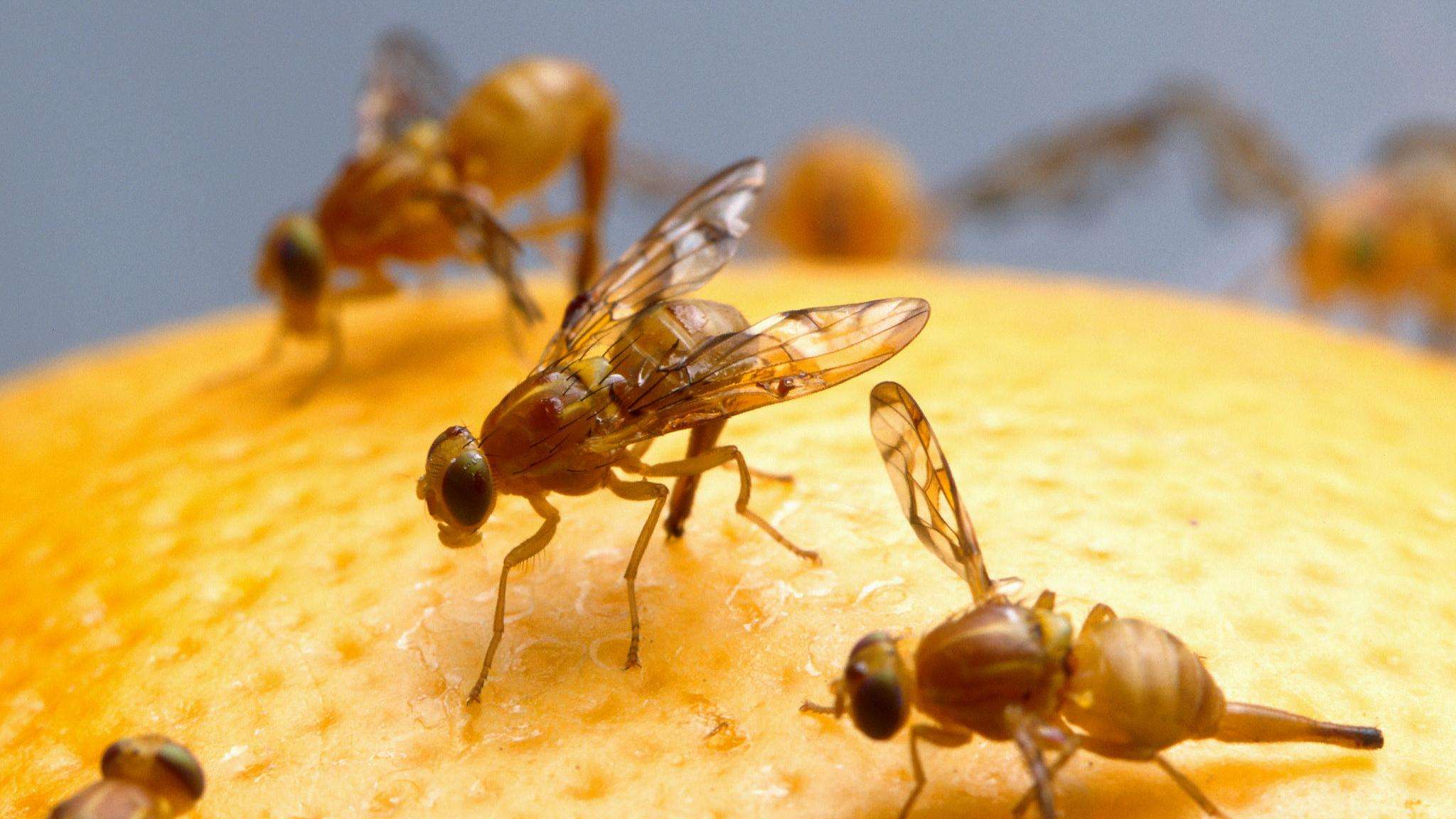Mexican Fruit Fly

The Mexican fruit fly (Anastrepha ludens or Mexfly) is a serious agricultural pest. It can infest more than 50 types of fruits and vegetables, particularly citrus and mango. The damage makes crops inedible and unmarketable.
Mexican fruit fly was first found in central Mexico in 1863 and along the California-Mexico border by the early 1950s. Today, Mexfly continues to pose a serious threat for the Texas citrus industry and a wide range of other valuable U.S. crops.
- Appearance
- Mexfly larvae (maggots) feed inside the fruit. They are legless, white to yellowish-white, and grow to a length of 0.4 inches.
- Adult mexflies are larger than a house fly. Their body is a pale orange-yellow with two to three whitish stripes along the thorax. The wings are clear with several yellow and brown stripes.
- Females also have a long, slender, tube-like organ called an ovipositor. They use this to deposit eggs beneath the fruit's skin.
- Damage
- Fruit decays early and falls to the ground as the larvae develop and feed on the pulp.
Download free apps at Explorer for ArcGIS to help you identify citrus pests, diseases, and cultivars.
Quarantined Areas
We need you to be vigilant to stop the spread of Mexfly and protect your State's citrus industry:
- Don't move or mail fruit from residential citrus trees from the quarantine area.
- Remove all citrus fruit as it ripens as soon as possible.
- Don't leave any ripe fruit hanging on the tree or laying on the ground.
- Double-bag any fruit not eaten or used and properly dispose of it in a trash bin.
- Don't compost any fruit (or vegetables) from the quarantine area.
Everywhere Else
Mexfly spreads mainly through infested fruits and vegetables. Here's how you can help prevent this:
- Do not bring or mail fresh fruits, vegetables, or plants into your State or another State unless agricultural inspectors have cleared them first.
- When returning from international travel, declare all agricultural products to U.S. customs officials. Learn more on our Traveler Information page.
- Know and follow all quarantine restrictions in fruit fly-infested areas.
- Never remove fresh produce from your property if your area is under a fruit fly quarantine.
- Fruits and vegetables may be consumed or processed (juiced, frozen, cooked, or ground in the garbage disposal) at the property of origin. If not consumed or processed, double-bag fruits and vegetables in plastic bags before throwing them away.
- Cooperate with agriculture officials who may be in your area surveying for the pest. We may ask for access to your property to place and check insect-monitoring traps.
Pest Tracker: Find Pests by State or Region
Find out if your State has a Federal quarantine and/or State-level quarantine for any hungry pests.
Report Plant Pests and Diseases
Have you seen this pest or signs of pest damage? Immediately report your findings to your State plant health director or State plant regulatory official.
If you suspect that you have a Mexican fruit fly infestation, contact your local cooperative extension service for advice. Please cooperate with local, State, and Federal agricultural officials as they carry out their work.
Controlling Mexican Fruit Fly
For the latest Mexican fruit fly quarantine information, select the name of your State in the Pest Tracker below, or view Fruit Fly Quarantine Maps, Federal Orders, SPRO Letters, and Environmental Documents.
Pest Tracker: Find Pests by State or Region
Find out if your State has a Federal quarantine and/or State-level quarantine for any hungry pests.
APHIS works to reduce the risk of Mexfly spreading northward into the United States from Mexico. The U.S.-Mexico border is an especially high-risk pest pathway because many people travel from fruit fly-infested areas of Central America and Mexico to the United States.
We follow specific program guidelines (198.25 KB) to rapidly respond to a Mexfly incursion. These guidelines address survey, treatment and regulatory response, and meet the requirements of the National Environmental Policy Act and other applicable laws and regulations.
When we detect Mexfly in an area, we work with State partners using a tiered approach. Our efforts may include surveying to delimit the extent of the incursion, conducting significant and ongoing public outreach, and establishing a parallel Federal-State quarantine in the affected area. Our response may also include sterile insect technique (SIT) using aerial and ground dispersal. When we use SIT, we release large numbers of sterile male fruit flies to mate with female fruit flies in the wild. Because these females do not produce any offspring, the wild fruit fly population declines and is eliminated.
Throughout the year in southern Texas and northern Mexico, we release an average of 165 million sterile Mexflies per week to support eradication and control programs along the border.
- Species Profile: Mexican Fruit Fly (USDA National Invasive Species Information Center)
- Brochure: Invasive Fruit Flies Impact You / Las plagas de moscas de la fruta lo afectan a usted (2.07 MB)
- Video: Mexican Fruit Fly - Texas

